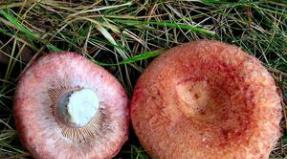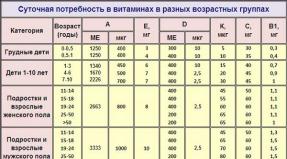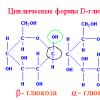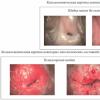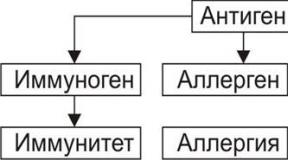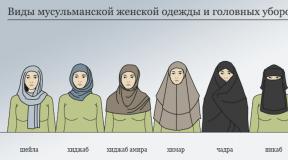Chitin is. Chitinous cover of arthropods. How to get the most chitin from food
Main source of information:
- Chitin and chitosan: Preparation, properties and application / Ed. K.G. Scriabin, G.A. Vikhoreva, V.P. Varlamov. - M.: Nauka, 2002. - 368 p.
1 Place of chitin in the classification of chemical compounds
Chitin (poly-N-acetyl-D-glucosamine) is a biopolymer widely distributed in nature. Polymers (from the Greek polymeros - consisting of many parts, diverse) are substances whose molecules consist of a large number of structurally repeating units - monomers. By origin, polymers are divided into natural or biopolymers (eg natural rubber) and synthetic (eg polyethylene). Due to mechanical strength, elasticity, electrical insulating and other properties, polymer products are used in various industries and in everyday life. The main types of polymeric materials are plastics, rubbers, fibers, varnishes, paints, adhesives, ion-exchange resins.
Biopolymers are many natural high-molecular compounds from which the cells of living organisms and the intercellular substance that binds them together are built. Biopolymers include proteins, nucleic acids, polysaccharides (complex carbohydrates) and so-called mixed biopolymers, for example, lipoproteins (complexes containing proteins and lipids), etc. Chitin is a nitrogen-containing polysaccharide (aminopolysaccharide). The monomers of polysaccharides are monosaccharides (monoses): glucose, fructose, galactose, etc.
Due to biological function polysaccharides are divided into reserve and structural. Most of the reserve polysaccharides (starch, glycogen, inulin) are the most important components of food products, performing the function of a source of carbon and energy in the human body. Structural polysaccharides (cellulose, hemicellulose) in the cell walls of plants form extended chains, which, in turn, fit into strong fibers or plates and serve as a kind of frame in a living organism. The most common biopolymer in the world is the structural polysaccharide of plants - cellulose. Chitin is the second most abundant structural polysaccharide after cellulose.. According to the chemical structure, physicochemical properties and functions performed, chitin is close to cellulose. Chitin is an analogue of cellulose in the animal world.
2 Chemical structure of chitin and chitosan
2.1 β-D-glucose
The elementary particle (monomer) of chitin is N-acetyl-β-D-glucosamine. The term glucosamine means chitin monomer is a derivative of glucose, more specifically, β-D-glucose.
Let's take a closer look at what β-D-glucose means. Chemical formula of glucose C 6 (H2O)6. It is well known from organic chemistry that different substances can correspond to a given formula. Substances that have the same chemical formula, molecular weight, atomic sequence, but different properties called stereoisomers. In stereoisomers, the difference in properties arises from the different arrangement of atoms in space. In monosaccharides, stereoisomers are formed due to the different configuration of the hydroxyl group OH and the hydrogen atom H refer to carbon atom C. Simplified, this can be represented by placing OH and H to the right or left of C. There are 4 such carbon atoms in the glucose molecule (circled in blue). In biochemistry they are calledasymmetric or chiral. By interchanging OH and H, 16 stereoisomers can theoretically be obtained. The most important glucose isomers are D-glucose and L-glucose. Not only glucose, but also other monosaccharides are either B- or L-isomers. The assignment of monosaccharides to D- or L-isomers is carried out by the location of the OH group at the carbon atom C, which is farthest away from the carbonyl group C=O (for glucose, these C=H and OH groups are circled in red).
In nature (fruits, vegetables, honey, etc.) only D-glucose is found. L-glucose is obtained synthetically.

Monosugars tend to form cyclic structures. It is the cyclic molecules of monosaccharides that combine to form polysaccharide molecules. In the crystalline state, monosaccharides are found only in cyclic form. Glucose forms a cyclic structure with 5 carbon atoms and one oxygen atom in the ring. When the cyclic structure of glucose is formed, one more 5th chiral carbon atom is added to the 4 existing chiral carbon atoms(circled in black). In the linear structure, this carbon atom was part of the C=O carbonyl group. This leads to the formation of 2 stereoisomers of D-glucose: α- when the OH of the 5th chiral carbon atom is located above the plane of the ring and β- below. This additional chiral atom is called abnormal, and α- and β-stereoisomers of D-glucose are called anomers. According to the physicochemical properties, α- and β-anomers differ significantly from each other. Entering polysaccharides as building blocks, they form completely different carbohydrates (for example, α-D-glucose forms amylose; β-D-cellulose). In aqueous solutions, α- and β-anomers easily pass into each other and an equilibrium is established between them: 64% β-D-glucose and 36% α-D-glucose.
2.2 β-D-glucosamine and N-acetyl-β-D-glucosamine

According to the classification of monosaccharide derivatives, glucosamine belongs to amino sugars. Amino sugars are derivatives of monosaccharides whose hydroxyl group -OH is replaced by an amino group -NH2(most often at 2 carbon atoms - see fig.). According to the IUPAC nomenclature, the names of amino sugars are formed by adding to the name of the "original" monosaccharide the name of the amino group that replaces the hydroxyl (with an indication of its position), and the prefix "deoxy", indicating the substitution. According to this nomenclature full name of β-D-glucosamine: 2-amino-2-deoxy-D-glucopyranose (D-glucosamine). 2-amino means that the amino group is attached to the 2nd carbon atom; 2-deoxy means that the 2 carbon atom does not have a hydroxyl group; ending pyranose present in monosaccharides of a cyclic structure. The simplified name comes from the root of the corresponding monosaccharide, to which the word "amine" is added, for example, glucosamine. Amino sugars, unlike other monosaccharides, are used not to obtain energy, but to form the connective tissues of the body.
N-acetyl-β-D-glucosamine is an acetylated β-D-glucosamine. Acetylation is the replacement of hydrogen atoms in organic compounds with an acetic acid residue CH3CO (an acetyl group). N-acetyl-β-D-glucosamine - it is a monomer (elementary, repeating structure) of chitin, and β-D-glucosamine - chitosan.
2.3 Chitin and chitosan

The chitin molecule consists of N-acetyl-β-D-glucosamine units. In living organisms in nature, only chitin can be formed, and chitosan is a derivative of chitin. The chitosan molecule consists of β-D-glucosamine units. Chitosan is obtained from chitin by deacetylation with alkalis. Deacetylation is the reverse reaction of acetylation, i.e. substitution of a hydrogen atom for the acetyl group CH3 CO. Therefore, unlike chitin, chitosan can have structural heterogeneity due to the incomplete completion of the deacetylation reaction. The content of residual acetyl groups CH3CO (circled in gray in the figure) can reach 30%, and the nature of the distribution of these groups can significantly affect some of the physicochemical properties of chitosan. In this way, with incomplete acetylation, the chitosan molecule consists of randomly linked N-acetyl-β-D-glucosamine units(main links) and β-D-glucosamine units(residual links).
Chitin, like cellulose, has two hydroxyl groups, one of which is secondary in C-3, and the second in C-6 is primary. These functional groups can be derivatized analogously to the corresponding cellulose derivatives. Among them, simple (for example, carboxymethyl) and esters can be noted. Chitosan has an additional reactive functional group (NH2 amino group), therefore, in addition to ethers and esters, it is possible to obtain N-derivatives of various types on chitosan. The presence of reactive functional groups in the structure of chitin and chitosan molecules makes it possible to obtain various chemical modifications suitable for use in various industries, agriculture, medicine, etc.
Chitin is a supporting component:
- cell tissue of most fungi and some algae;
- outer shell of arthropods(cuticle in insects, shell in crustaceans) and worms;
- some organs of molluscs.
In insects and crustaceans, fungal and diatom cells chitin in combination with minerals, proteins and melamines forms the external skeleton and internal support structures.
Melanins (from Greek melas, genitive melanos - black), brown and black (eumelanins) or yellow (pheomelanins) are high-molecular water-insoluble pigments. Widely distributed in plant and animal organisms; determine the color of integuments and their derivatives (hair, feathers, scales) in vertebrates, cuticles in insects, peels of some fruits, etc.
Potential sources of chitin are diverse and widespread in nature. The total reproduction of chitin in the world's oceans is estimated at 2.3 billion tons per year, which can provide a global production potential of 150-200 thousand tons of chitin per year.
The shells of commercial crustaceans are the most accessible for industrial development and a large-scale source of obtaining chitin. It is also possible to use gladius (skeletal plate) of squid, cuttlefish sepion, biomass of micellar and higher fungi. Domesticated and farmed insects, due to their rapid reproduction, can provide a significant biomass containing chitin. Such insects include silkworms, honey bees and house flies. In Russia, a massive source of chitin-containing raw materials is the king crab and snow crab, the annual catch of which in the Far East is up to 80 thousand tons, as well as the shrimp in the Barents Sea.
It is known that crustacean shells are quite expensive raw materials, and despite the fact that more than 15 methods have been developed for obtaining chitin from them, the question was raised about obtaining chitin and chitosan from other sources, among which small crustaceans and insects were considered.
Due to the wide distribution of beekeeping in our country, it is possible to obtain chitinous raw materials (dead bees) on a significant scale. As of 2004, there were 3.29 million bee colonies in the Russian Federation in all categories of farms. The strength of the bee family (the mass of worker bees in the bee family, measured in kg) is on average 3.5-4 kg. In the summer, during the period of active honey collection and in the spring after wintering, the bee colony is updated by almost 60-80%. Thus, the annual raw material base of dead bees can be from 6 to 10 thousand tons, which makes it possible to consider dead bees as a new promising source of insect chitosan along with traditional types of raw materials.
Chemical composition of various types of chitin-containing raw materials, % of dry matter
Chitin, which is part of the shell of crustaceans, forms a fibrous structure. In crustaceans, immediately after molting, the shell is soft, elastic, consisting only of a chitin-protein complex, but over time it hardens due to the mineralization of the structure mainly with calcium carbonate. Thus, the shell of crustaceans is built from three main elements - chitin, which plays the role of a frame, a mineral part that gives the shell the necessary strength, and proteins that make it a living tissue. The composition of the shell also includes lipids, melanins and other pigments.
In the cuticle of adult insects, chitin is also covalently bound to proteins such as artrapodin and sclerotin, as well as a large number of melanin compounds, which can make up to 40% of the mass of the cuticle. The cuticle of insects is characterized by great strength and at the same time flexibility due to chitin. The advantage of dead bees is the minimum content of mineral substances, since the cuticle of insects is practically not mineralized. In this regard, there is no need to carry out a complex demineralization procedure.
Mass sources of PSS are available in many countries, but the industrial production of chitin and chitosan is mastered mainly in Japan, where, according to 1998 data, up to 2500 tons of chitin and chitosan are produced annually. About 1000 tons of chitosan and other modifications of chitin are produced in the USA per year. European countries (Italy, Norway, Poland) produce up to 100 tons of chitosan per year. In recent years, the development of industrial production of chitin and its derivatives has been developing in India, China and Thailand. As a raw material for the production of polymers, in Japan and China, PSS from the processing of crabs and shrimp are used, and in the USA - PSS from crabs and lobsters. The domestic industry began to master the production of chitin and chitosan in 1970-1980. and to date, the total volume of their output reaches 80 tons per year. (Apitherapy. / Khismatullina N.3. - Perm: Mobile, 2005. - 296 p.)
4 Physico-chemical properties and applications of chitin and chitosan
Chitin and its deacetylated derivative chitosan have attracted the attention of a wide range of researchers and practitioners due to a complex of chemical, physicochemical and biological properties and an unlimited reproducible raw material base. The polysaccharide nature of these polymers determines their affinity for living organisms, and the presence of reactive functional groups (hydroxyl groups, amino group) provides the possibility of various chemical modifications that enhance their inherent properties or impart new ones in accordance with the requirements.
Interest in chitin and chitosan is associated with their unique physiological and environmental properties such as biocompatibility, biodegradation (complete decomposition under the action of natural microorganisms), physiological activity in the absence of toxicity, the ability to selectively bind heavy metals and organic compounds, the ability to form fiber and film, and others
The process of obtaining chitin consists in removing the last mineral salts, proteins, lipids, pigments from the raw material; therefore, the quality of chitin and chitosan depends largely on the method and degree of removal of these substances, as well as on the conditions for the deacetylation reaction. The requirements for the properties of chitin and chitosan are determined by the areas of their practical use, which are very diverse. In Russia, as in other countries, there is no single standard, but there is a division into chitin and chitosan technical, industrial, food and medical.
On the website of the company "Chitin and Chitosan", which produces chitin and chitosan on an industrial scale, the following areas of their application are listed:
- nuclear industry: for localization of radioactivity and concentration of radioactive waste;
- medicine: as suture materials, wound and burn healing dressings. As part of ointments, various medicinal preparations, such as enterosorbent;
- agriculture: for the production of fertilizers, protection of seeds and crops;
- textile industry: when sizing and anti-shrink or water-repellent treatment of fabrics;
- paper and photographic industry: for the production of high-quality and special grades of paper, as well as for improving the properties of photographic materials;
- in the food industry, it acts as a preservative, clarifier for juices and wines, dietary fiber, emulsifier;
- as a food additive shows unique results as an enterosorbent;
- in perfumery and cosmetics it is a part of moisturizing creams, lotions, gels, hairsprays, shampoos;
- in water treatment it serves as a sorbent and flocculant.
According to the chemical structure, chitin is close to cellulose. Like cellulose molecules, chitin molecules are highly rigid and tend to form supramolecular structures (the so-called fibrillar structures). In fibrillar structures, chitin molecules, held together by hydrogen bonds, arranged in almost parallel bundles, form structures that are regular in 3 dimensions, which is typical for crystals. There are several types of such crystalline formations (α-,β-,γ-chitins), which differ in the degree of ordering and mutual orientation of polymer molecules (polymorphism).
One of the most important properties of polymers, which in many cases determines the possibility of their processing and application, is their solubility. Chitin is insoluble in water, solutions of organic acids, alkalis, alcohols and other organic solvents. It is soluble in concentrated solutions of hydrochloric, sulfuric and formic acids, as well as in some salt solutions when heated, but when dissolved it depolymerizes markedly. In a mixture of dimethylacetamide, N-methyl-2-pyrrolidone and lithium chloride, chitin dissolves without destroying the polymer structure. Low solubility makes it difficult to process and use chitin.
Chitosan obtained from chitin dissolves in solutions of both organic and inorganic acids (except sulfuric). Unlike practically insoluble chitin, chitosan, which is soluble even in solutions of organic acids, has wider applications in the food industry, medicine, agriculture, and other industries.
Also important important properties of chitosan are hygroscopicity, sorption properties, swelling ability. Due to the fact that the chitosan molecule contains many hydroxyl, amine and other extreme groups, its hygroscopicity is very high (2-5 molecules per one monomer unit, which is located in the amorphous regions of polymers). According to this indicator, chitosan is second only to glycerin and surpasses polyethylene glycol and kalleriol (high polymer alcohol from pear). Chitosan swells well and firmly retains the solvent in its structure, as well as the substances dissolved and suspended in it. Therefore, in the dissolved form, chitosan has much greater sorption properties than in the undissolved form.
Chitosan can be biodegraded by chitinase and lysozyme. Chitinases are enzymes that catalyze the decomposition of chitin. They are produced in organisms of animals containing chitin. Lysozyme is produced in the body of animals and humans. Lysozyme is an enzyme that destroys the wall of a bacterial cell, resulting in its dissolution. Creates an antibacterial barrier in places of contact with the external environment. Contained in saliva, tears, nasal mucosa. Products made of chitosan completely decomposing under the action of natural microorganisms do not pollute the environment.
In appearance, chitosan is flakes less than 10 mm in size or powders of various fineness of grinding, from white to cream, often with a yellowish, grayish or pinkish tint, odorless. Other properties of dry chitosan are electrification and astringent taste. By toxicity, chitosan belongs to the 4th class and is considered safe.
Chitosan proved to be an effective radioprotector, a sorbent of toxins and heavy metals in the body, an element of therapeutic and preventive nutrition, a plant protection agent, an immunomodulator in veterinary medicine, and also in other areas. To date, more than 70 applications of chitosan are known.
Japanese experts called chitosan the substance of the 21st century. In their opinion, in two or three decades, industrial civilization will be unthinkable without it, just as without aluminum, polyethylene or a personal computer.
5 Low molecular weight chitosan. Apizan
To expand the scope of chitosan in medicine, its solubility at neutral pH values is of great importance, which can be achieved by reducing its molecular weight. As practice shows, the molecular weight of chitosan obtained from the shell of crustaceans by chemical and enzymatic methods is high and amounts to 103 kDa. Such chitosans are soluble only in aqueous solutions of organic and mineral acids, which is not always convenient. To obtain chitosan soluble in neutral solutions (at pH = 7), the initial chitosan is subjected to hydrolysis using chemical reagents or enzymes.
As a hydrolyzing reagent, perhydrol is most often used in the form of a 3-10% aqueous solution with moderate heating to 30-50 ° C. Hydrolysis reduces the molecular weight of chitosan and improves its solubility in slightly acidic aqueous solutions. This results in a polydisperse product in terms of molecular weight, soluble in dilute acid solutions at pH > 5.
Enzyme complexes of various origins are used as enzyme preparations for the degradation of chitin and chitosan. These can be enzyme complexes of crab or krill hepatopancreas, as well as pancreatin from the pancreas of cattle. But more often, enzyme complexes with chitinolytic activity of microbiological origin are used for this purpose. The use of enzyme preparations for the degradation of chitosan makes it possible to obtain low molecular weight chitosans, soluble in water and possessing at the same time an order of magnitude higher biological activity compared to high molecular weight chitosans. Such properties of low molecular weight chitosan significantly expand the scope of their application as medical polymers. For example, based on low molecular weight chitosans, effective radioprotectors, chiral selectors for various medical substances, and anticoagulants with high heparin activity have been developed.
Chitosan, isolated from the chitinous cover of bees, is also subjected to hydrolysis by a complex of enzymes of microbial origin to make it water soluble. The result is a product called apizan (pchelozan). Apizan at the end of the technological chain of its production, after freeze-drying, is a fine powder of light brown color, soluble in an acidic medium at pH=5.5, has a moisture content of 8-10%, an ash content of 1-2%, the degree of deacetylation is 80-85 %( Practical apitherapy. / Khismatullina N.3. - Perm: ExLibrum, 2009. - 336 p.).
Often, on sites about bee products, you can find, for example, such an absurd statement about the benefits of bee san: "... Low molecular weight chitosan obtained from the cuticle of bees is absorbed completely, in contrast to high molecular weight chitosan obtained from the shell of crustaceans, which is partially absorbed." First, at the end of the technological chain of production, both chitosan are low molecular weight. Secondly, and most importantly, by its biological nature, chitosan belongs to dietary fibers that are not absorbed at all or are absorbed very poorly. Their main advantage is the ability to pass through the gastrointestinal tract without being absorbed "mechanically" cleansing it (see page
Chitin is the main structural substance of the cell walls of fungi, as well as the integument of arthropods. It has good waterproof properties and is also an excellent structural component. Man was able to use chitin for his own purposes. What is it and why has it become so popular today?
The structure of the molecule
Since it is a polymer, it is made up of many individual molecules of glucose isomers. These isomers are called N-acetyl-β-D-glucosamine, and due to the unusual beta bond in the composition, they are able to form branched polymer chains.
Chitin is sometimes referred to as chitosan. Its main difference is that it is very similar in structure to the well-known cellulose, which is part of the cell walls of plants. If the latter ranks first in production and isolation from plant tissues, then chitin, in turn, comes second in this ranking. This once again proves the popularity of the substance in industry and cosmetology.
In nature
Chitin is absent in plants, since their cell walls already contain another biopolymer - cellulose. On this basis, true plants and algae are distinguished, and the presence of one of the biopolymers is a comparative characteristic of different kingdoms of organisms.

Isolation of chitin
On an industrial scale, chitosan is isolated from crustaceans, although this is a rather expensive business. Therefore, the technique for isolating this polymer is constantly being modernized, and as a result, new sources of natural chitin have been found.
Thus, the high rate of reproduction of insects has become the main reason why chitin is extracted from bees or houseflies. What are these flies of yours, you ask. However, if you look at an industrial scale, the production of chitin from insects has taken a big turn, and a sufficient amount is obtained at the output. So, in Russia, some points for growing bees for the purpose of extracting chitin have already been developed.
Do not forget about fungi, as well as some algae, since the cell membranes of these organisms contain chitin, it is isolated in the same way as cellulose in plants. Although the efficiency of such a business leaves much to be desired, it cannot be excluded from the list of possible sources of chitosan.

The value of chitin for humans
What is chitin in biology? It is not only a structural component that prevents water loss, but also a biopolymer with bactericidal properties. This makes it possible to use chitin in the production of bandages, gauze and special bath sponges.
Chitin binds well with fats. If a person takes special medicines, which contains a certain proportion of chitosan, fats in the intestines bind to the biopolymer and are excreted from the body along with it. As a result, the amount of digestible fat decreases, which lowers the amount of cholesterol in the body. However, chitin can also play a trick on a person if used in excess, it also reduces the content of vitamin E and leads to other unpleasant consequences.
Chitosan has recently been added to cosmetic products as a natural ingredient. Such cosmetics make the skin supple, healthy nails, and hair after the action of shampoos with chitin in the composition become shiny and healthy.
In Asian countries, as well as in the West, many markets sell fried grasshoppers, locusts and other representatives of arthropods. Entomophagy has recently become popular among gourmets, thanks to the content of such useful chitin in the composition of the integuments of small insects and crustaceans.

Doctors have found that chitin helps with wound healing, due to its high compatibility with animal tissue. This makes it possible to use the biopolymer in the manufacture of special healing ointments, but the study of such properties of chitosan is still ongoing.
There is a very high nutritional value of such a biopolymer as chitin. What can give a handful of small insects, which is even difficult to chew? The answer will amaze you: 100 grams of grasshoppers can give the body 20.5 grams of protein, when the nutritional value of regular beef is not much different and is 22.5 grams. The only problem is that harvesting 100 grams of small grasshoppers is much harder than cutting 100 grams of meat cattle.
Mushrooms are a real superfood. They have B vitamins, potassium, copper, zinc, selenium, and many other nutrients. But what is especially interesting about the composition of mushrooms is their unique texture, which has no analogues among other representatives of nature. And the substance chitin is responsible for the “fleshy” structure of mushrooms. Yes, yes, the same chitin, known from biology lessons, which is contained in the shells of crustaceans and insects. It is thanks to the unique chemical structure that fungi have been isolated in a separate kingdom. But what role is assigned by nature to chitin, other than to create shells and give uniqueness to mushrooms?
What is chitin
Chitin is the second most abundant biopolymer on the planet.
According to some estimates, exactly as much of this substance is produced annually in nature as cellulose. From a chemical point of view, it is a nitrogen-containing straight chain polysaccharide. Under natural conditions, it is part of complex organic and inorganic compounds.
Chitin as a natural biopolymer is found mainly in the exoskeleton (outer part of the skeleton) of shrimp, crabs, lobsters, crayfish. Also found in fungi, yeast, some bacteria and butterfly wings. In the human body, it is necessary for the formation of hair and nails, and in birds - plumage. Pure chitin is more fragile than in combination with other substances. Insect exoskeletons are a combination of chitin and proteins. Crustacean shells are usually composed of chitin and calcium carbonate.
Chitin has many commercial analogues, including food and pharmaceutical products. They are commonly used as food thickeners and stabilizers, and help create an edible film on foods.
In food products, chitin is presented in a modified and more bioavailable form of chitosan. Chitosan is a derivative of chitin, formed as a result of exposure to a substance with temperature and alkali. According to scientists, this substance in its composition resembles the tissues of the human body. For industrial purposes, it will be obtained from the shells of crustaceans.
Discovery history
The discovery of chitin falls on 1811, when Professor Henry Braconneau first discovered it in mushrooms. The scientist with particular interest began to study an unknown substance that did not succumb to the influence of sulfuric acid. Then (in 1823) this substance was found in the wings of May beetles and was named "chitin", which in Greek means "clothing, sheath". This material was structurally similar to cellulose, but was much stronger. The structure of chitin was first determined by the Swiss chemist Albert Hofmann. And in 1859, the scientific world learned about chitosan. After chemists "cleared" chitin from calcium and proteins. This substance, as it turned out, has a beneficial effect on almost all organs and systems of the human body.
Over the next century, interest in chitin faded a little, and only in the 1930s it grew with renewed vigor. And in the 1970s, the production of a substance from mollusk shells began.
Chitin in nature
As already noted, chitin is the main component of the exoskeleton (the outer part of the skeleton) of many arthropods, such as insects, spiders, and crustaceans. Exoskeletons made from this tough and hard substance protect the sensitive and soft tissues of animals that lack internal skeletons.
Chitin is similar in structure to cellulose. And the functions of these two substances are also similar. Since cellulose gives strength to plants, chitin strengthens animal tissue. However, it does not perform this function on its own. Proteins come to his aid, including elastic resilin. The strength of the exoskeleton depends on the concentration of certain proteins: whether it will be rigid, like the shell of a beetle, or soft and flexible, like the joints of crabs. Chitin can also be combined with non-protein substances such as calcium carbonate. In this case, crustacean shells are formed.
Animals that wear a "skeleton" on the outside are relatively inflexible due to the stiffness of the armor. Arthropods can only bend limbs or segments of their body at joints where the exoskeleton is thinner. Therefore, it is important for them that the exoskeleton matches the anatomy. In addition to the role of a hard shell-shell, chitin prevents the drying and dehydration of the bodies of insects and arthropods.
But the animals grow, which means that from time to time they need to correct the "size" of the armor. But since the chitinous structure cannot grow with the animals, they shed the old shell and begin to secrete a new exoskeleton with the glands of the epidermis. And while the new armor hardens (which will take a little time), the animals become extremely vulnerable.
Meanwhile, nature endowed only small animals with chitin shells; such armor would not protect larger individuals of the fauna. It would not fit terrestrial invertebrates either, because over time chitin gets fatter and heavier, which means that animals would not be able to move under the weight of this protective armor.
Biological role in the body
Once in the human body, chitin, which has the ability to bind dietary lipids, reduces the activity of fat absorption in the intestine. As a result, the level of cholesterol and triglycerides in the body decreases. On the other hand, chitosan is able to influence calcium metabolism and accelerate its excretion in the urine. Also, this substance can significantly reduce the level of vitamin E, but positively affect the mineral composition of bone tissue.
In the body, chitin-chitosan plays the role of an antibacterial substance.
For this reason, it is included in some wound care products. Meanwhile, long-term use of chitin can disrupt the healthy microflora of the gastrointestinal tract and activate the growth of pathogenic microflora.
Functions of chitin and chitosan:
- component of baby food;
- useful nutritional supplement;
- lowers cholesterol;
- fiber source;
- promotes the reproduction of bifidobacteria;
- helps with lactose intolerance;
- important for weight loss
- antiulcer component;
- essential for bone strength;
- beneficial effect on eye health;
- relieves gum disease;
- anticancer agent;
- component of cosmetics;
- component of many medical products;
- flavoring agent, preservative;
- used for the production of textiles, paper;
- seed treatment agent;
- important for water purification.
What is it needed for
There is a good deal of scientific evidence that shows the effect of chitin on lowering cholesterol levels. This property is especially noticeable in the combination of chitosan and chromium. For the first time this effect on the example of rats was proved by Japanese scientists in 1980. The researchers then discovered that cholesterol reduction is due to the ability of chitin to bind lipid cells, preventing them from being absorbed by the body. Then, Norwegian scientists announced the results of their experience: in order to reduce cholesterol levels by almost 25 percent, it is necessary to take chitosan in addition to diets for 8 weeks.
The positive effect of chitin is also felt by the kidneys. This substance is especially important for maintaining optimal well-being in people undergoing hemodialysis procedures.
The effect on the skin is to activate the ability to quickly heal wounds.
Dietary supplements containing chitosan help maintain a healthy weight.
Affects the body on the principle of soluble fiber. So, it improves the functioning of the digestive organs, accelerates the passage of food through the intestinal tract, improves intestinal motility.
Improves the structure of hair, nails and skin.
Beneficial features
Numerous studies have shown that chitin and its derivatives do not have toxicity, which means that they can be safely used in the food and pharmaceutical industries. According to some data, about 2 million people take chitin-based dietary supplements in the USA and Japan alone. And their number is only growing. By the way, Japanese doctors recommend that patients take chitin as a remedy for allergies, high blood pressure, and arthritis.
In addition, it is known that chitin is completely decomposed under the influence of microorganisms, and therefore is an environmentally friendly substance.
Hitin and...
…digestion
Introducing chitin into your regular diet is the best thing a person can do for their health. So, at least, say some researchers. After all, the consumption of this substance will not only help to lose weight, but also lower blood pressure, prevent the occurrence of ulcers in the digestive system, and facilitate the digestion of food.
Several studies conducted in Japan and Europe have shown that chitin and its derivatives promote the growth of beneficial bacteria in the gut. Also, scientists have reason to believe that chitin not only improves the functioning of the colon (relieving irritable bowel syndrome), but also prevents the formation of malignant tumors and polyps in the tissues.
It has been proven that this unique substance protects against gastritis, stops diarrhea, relieves constipation, and removes toxins.
…lactose
This may be surprising, but the results of the research are convincing in the truth of this assumption. Chitin alleviates lactose intolerance. The results of the experiments surprised even scientists. It turned out that against the background of chitin, even food, which is 70 percent lactose, does not cause symptoms of indigestion.
…excess weight
Today, there is some evidence that chitin is a fat blocker. When a person consumes this carbohydrate, it binds to lipids that have entered the body with food. And being an insoluble (indigestible) component, the bound fat automatically gives the same ability. As a result, it turns out that this strange “blowing” travels through the body without being absorbed into it. It has been experimentally established that for weight loss it is necessary to consume 2.4 g of chitosan per day.
…wound healing
Chitin is one of the most important substances for patients with burn wounds. It has remarkable compatibility with living tissue. Scientists have noticed that thanks to this substance, wounds heal faster. It turned out that the acidic mixture of chitin accelerates the healing of injuries after burns of varying degrees. But the study of this ability of chitin continues.
…mineralization
This polysaccharide plays a decisive role in the mineralization of various tissues. And the prime example of this is mollusk shells. Researchers, having studied this ability of chitin, have high hopes for this substance as a component for bone tissue repair.
“Did you order locusts for lunch?”
Chitosan burst into the food industry in the 1990s. When advertising a new nutritional supplement, manufacturers repeated that it helps to reduce weight and cholesterol, prevents osteoporosis, hypertension, and stomach ulcers.
But, of course, the use of chitin in food did not begin at the end of the last century. This tradition is at least several thousand years old. Residents of the Middle East and Africa have been consuming locusts since time immemorial as a healthy and nutritious dish. There are mentions of insects as food on the pages of the Old Testament, in the records of the ancient Greek historian Herodotus, in the ancient Roman annals, in the books of the Islamists and in the legends of the Aztecs.
Among some peoples of Africa, dried locust with milk was considered a traditional dish. In the East, there was a tradition of presenting insects to a husband as the highest gift. In Sudan, termites were considered a delicacy, and boiled ants were the highlight of Aztec dinner parties.
There are different opinions about such gastronomic tastes. But in many countries of the East, they still sell fried locusts, in Mexico they cook grasshoppers and bedbugs, Filipinos enjoy various cricket dishes, and in Thailand, tourists will be willingly offered specific delicacies from beetle larvae, crickets, caterpillars and dragonfly dishes.
Grasshoppers alternative to meat?
Beetle eating in the modern world is treated differently. Some are thrown into the heat just by the thought that someone somewhere clicks instead of cockroach seeds. Others decide to taste gastronomic exotics while traveling the world. And for the third, grasshoppers and all the chitinous brethren serve as ordinary food, which has been held in high esteem for hundreds of years.
This fact could not but interest the researchers. They began to study what a person can get useful by consuming insects. As expected, scientists have determined that all this "buzzing exotic" supplies a person with chitin, which, no doubt, is already a plus.
In addition, in the course of studying the chemical composition of insects, it turned out that some contain almost as much protein as beef meat. For example, 100 g of grasshoppers contain 20.5 g of protein, which is only 2 g less than in beef. Dung beetles have about 17 g of protein, termites have 14, and bee bodies have about 13 g of protein. And everything would be fine, but collecting 100 g of insects is much harder than buying a 100-gram piece of meat.
Be that as it may, but at the end of the 19th century, the Briton Vincent Holt founded a new trend for gourmets and called it entomophagy. The adherents of this movement, instead of meat-eating or vegetarianism, "professed" feeding on insects. Supporters of such a diet considered their diet, rich in chitin, almost medicinal. And the dishes from their menu are healthier and cleaner than animal products.
How to get the most chitin from food
Shrimp belong to the list of foods with the highest chitin content. But if you really want to get the maximum of the substance from this product, then preference should be given not to royal, but to smaller specimens. Their shells are easier to chew, and chitin from them is more easily absorbed by the body. If you take fish as a source of chitin, then you need to cook it exclusively with scales. Well, do not forget about mushrooms, from which you can cook dozens of dishes. And the best part is that you don't have to chew anyone's shells or scales.
Pharmaceutical analogue
Fried grasshoppers, cockroaches or dung beetles are, of course, not a unique source of chitin. A modern person can easily renew the reserves of a substance in the body, avoiding such an exotic cuisine. It is not for nothing that researchers have been learning for decades to isolate this useful component from natural sources.
In the Soviet Union, for example, a medication with chitin appeared in the second half of the 20th century. True, then this development was kept under the heading "Secret". Soviet scientists after a series of experiments on mice, dogs and monkeys proved the effectiveness of chitin in the treatment of radiation. A few years later, the efficacy of the drug was tested on humans.
Then it turned out that, in addition to protecting against radio emissions, this substance is effective against allergies, oncological formations, intestinal dysfunction and hypertension. At present, research is ongoing. And not so long ago, scientists were able to get chitosan from bees. This event served as a new impetus in the development of the science of chitinology.
Consumption rates
A daily dose not exceeding 3 g is considered a safe dose of chitin. Otherwise, instead of improving motility, the gastrointestinal tract may malfunction.
Meanwhile, more active consumption of this polysaccharide is allowed for overweight people and high cholesterol. It is also worth paying attention to the maximum allowed daily allowance of chitin for fatty degeneration of the liver, impaired metabolism, diabetes mellitus and allergic conditions. In addition, people with diabetes mellitus, frequent constipation, intoxication, and also after transplantation of skin areas feel an increased need for chitin.
On the contrary, it is not advisable to get carried away with mushrooms and crustaceans for people with dysbacteriosis, flatulence, gastritis, pancreatitis, and inflammation in the digestive organs.
Side effects
Studies confirm that chitin has an extremely low level of toxicity. Side effects are possible in people with shellfish allergies. This is manifested, as a rule, in the form of constipation and flatulence. Excessive consumption of chitosan complicates the work of the digestive system, up to a complete blockage.
How to recognize a deficiency
Elevated cholesterol is one of the symptoms of chitin deficiency. Violation of the kidneys may also indicate a lack of substance from the shells of mollusks. And even pediculosis (lice), as some researchers say, also appears when the body lacks chitin.
Other symptoms include:
- physical weakness;
- loss of appetite;
- obesity;
- sleep disturbance;
- frequent allergies;
- intestinal disorders;
- pain in the joints;
- excess sludge.
What are the benefits of old crabs
Plants serve as a source of cellulose for humans, which is, if I may say so, a natural analogue of plastic. Many years ago, scientists learned how to make a lot of this material, including plastic and viscose.
But some animals can also produce natural "plastic". And in the world of fauna it is chitin. For many years, crab meat was used in the food industry, and the shells of these crustaceans were thrown away. Several thousand tons annually. And all because scientists could not figure out how to extract chitin from these shells. And only in 1975, chemists were able to isolate the necessary substance from the armor for the first time and process it into the desired form. This is how a surgical thread appeared, which does not cause allergies, promotes the rapid healing of wounds, and then dissolves in the body. This discovery was an incredible impetus in the development of medicine. It's hard to believe, but all this is thanks to the crab shells, which until recently were thrown away as garbage.
Areas of use of chitin
Man has found many ways to use chitin for his own good. So in medicine, durable chitin is used to create surgical threads. Because of its ability to quickly absorb water, it has become a part of tampons and sponges. Chitin has strong antibacterial, antiviral, and antifungal properties. For this reason, it often serves as an additional component of medical bandages, dressings.
In the digestive industry, chitin is included in many products as a thickening component. In addition, the substance is used in water purification from fats, salts of heavy metals, toxins, as a component of pet food. It is also included in many cosmetics and even serves as a component for the manufacture of underwear. Chitin is used in biomedicine, microbiology, and agriculture. Beekeepers use apizan, a product based on low molecular weight chitosan, to fight mites.
Chitin in cosmetology
Recently, among the range of cosmetic products, chitin-based preparations are gaining popularity. Modern shampoos, balms and hair styling products, toothpastes, creams and gels often contain this useful polysaccharide. The extract obtained from crustacean shells restores skin elasticity, strengthens nails, and covers hair with a protective film. If we talk about hair, then thanks to the chitinous “coating”, they are easier to comb, acquire a healthy shine, do not become electrified, and look more voluminous. And with all this, they retain the ability to breathe.
New generation anti-aging cosmetics incorporates a chitin derivative - chitosan. It smoothes wrinkles, refreshes skin color, improves blood circulation. The same substance is introduced into the composition of anti-obesity drugs, since it helps to remove excess fluid and toxins from body tissues.
Chitin recipes
Folk healers also never ignored chitin. In particular, bees and their metabolic products have always been valued in Russia. But now - about bees, as a source of useful chitin. The preparation of many medicinal products is based on dead bees (dead insects). They just serve as a source of chitin. Most often, water and alcohol tinctures are prepared from dead bees. These remedies were used in folk medicine to quickly heal wounds, prevent scarring, and also as a hemostatic, analgesic and general tonic.
Alcohol tincture to strengthen the body
Ingredients:
- bee subpestilence - 1 tablespoon;
- alcohol 40 percent.
How to cook
Grind the dead bee (you can use a coffee grinder) and pour with alcohol. Leave the mixture for 21 days in a dark place. During this time, shake the mixture regularly (at least once a day). Store in a tightly closed container in a dark place.
The remedy is taken to strengthen the immune system and cleanse the body.
Water infusion for weight loss
Ingredients:
- bee subpestilence - 2 tablespoons;
- boiling water - 500 ml.
How to cook
Podmore pour boiling water, bring to a boil and simmer for 2 hours over low heat. Strain, cool. Take three times a day, 1 tablespoon before meals (for half an hour).
The tool regulates hormonal balance, accelerates the burning of fat, promotes weight loss.
Powder against tuberculosis (from Medvedka)
Two days before the preparation of the recipe, the bear is put "on a starvation ration." This technique allows you to clean the digestive tract of the insect. Then disinfected with alcohol. And only after that they start drying. It is best to dry in the oven at a low temperature. Grind dry insects in a coffee grinder. Take mixed with honey 2-3 times a day. Single dosage - 1 teaspoon.
Chitin remained an unsolved substance for researchers for a long time. But every year scientists learn more and more about this unique polysaccharide. And the more discoveries are made, the more they admire the properties of chitin. And not so long ago in scientific circles they started talking about the potential possibility of creating an unlimited number of products from chitin. How realistic these ideas are remains to be seen.
Chitin (physical) - the substance of which the upper cuticular cover of arthropods mainly consists, called chitin, or even sometimes simply X., which, of course, is not entirely accurate. X. is a nitrogenous substance, but exhibits some of the characteristics of carbohydrates. Zundvik believes that X. is an amine derivative of a carbohydrate of the general formula n(C 12 H20 O10 ), and according to Kirch, X. is a product of the breakdown of protein bodies, in which glycogen is formed as a by-product. The X. formula according to Zundvik is as follows: H 100 N8 O38 + n (H2 O), where n ranges between 1 and 4. The similarity with carbohydrates, according to Zander, is expressed in the same reaction under the action of iodine in the presence of zinc chloride, and the deeper layers of X . are stained purple. Pure X. has the form of a colorless amorphous substance, insoluble in boiling water, alcohol, ether, alkalis and acids. In concentrated mineral acids, it dissolves, but at the same time it decomposes. X., except for arthropods, is also found in other invertebrates, for example. in brachiopods, annelids and roundworms, protozoa. However, in many cases the similarity of substances described as chitinous is doubtful. In fungi, the cell membranes, it turns out, contain nitrogen and are close in composition to X. The chitinous layer of arthropods, etc., is a derivative of the chitinous (see), lying under it, but it is not a liquid, then hardening release of the chitinous layer. According to Holmgren's observations of insects, and mainly of Thulberg's observations of lobsters, the young chitinous layer has a distinct rod-like or columnar structure. These sticks represent a continuation of the fibers into which the outer parts of the protoplasm of chitinogenic cells break down and which are now compared with the ciliated hairs of the ciliary epithelium, and between these sticks a layered substance is already deposited (in the lobster), filling the gaps between them and giving X. its usual layered structure. Thus, one must think that the chitinous layer is the result of a modification of the protoplasm of chitinous cells. On the surface of the chitinous layer, you can see a thin layer of the cuticle, which is the first to form and probably corresponds to the cuticular cover of the primary tracheal (see). On the surface of the chitinous layer, various sculptural patterns are also noticed, most often representing the imprint of the cells of the chitinous layer, as well as tubercles, spines, ribs, folds, hairs, scales, etc. The hardness of the chitinous cover is different and does not depend on its thickness. In the joints of two chitinous segments, the chitinous layer is very often very thickened, but it is softer and more flexible, which makes the joint mobile. This flexible layer is called the arthrodial or articular membrane. Sometimes the articular membrane grows extremely and thickens, as is the case with arthropods that swell due to various conditions, for example. in female termites, in fleas (Sarcopsylla, Vermipsylla) that swell when sucked, in ticks, etc. Sometimes the chitinous cover is impregnated with lime deposits, as, for example, in many crustaceans (see), and due to this it receives special hardness and brittleness, which at the same time, it makes molting more difficult and more painful, since the young chitinous cover is devoid of lime and soft, and, consequently, the animal must be ill and wait in the shelter until the cover takes on its usual hardness.
Δ.
Encyclopedic Dictionary F.A. Brockhaus and I.A. Efron. - St. Petersburg: Brockhaus-Efron. 1890-1907 .
Synonyms:See what "Khitin" is in other dictionaries:
- (new lat., from Greek chiton chiton). A substance contained in the outer integument of segmented animals, as well as in the horny parts of the body in general. Dictionary of foreign words included in the Russian language. Chudinov A.N., 1910. KHITIN is the main component ... Dictionary of foreign words of the Russian language
A supporting polysaccharide in invertebrates (forming the basis of the external skeleton of arthropods) and a component of the cell wall of fungi and some green algae. A linear polymer of N acetyl O glucosamine residues linked by (? 1,4 glycosidic bonds; in ... ... Biological encyclopedic dictionary
Chitin, a hard, hard substance widely distributed in nature; in particular, the hard shells (EXOSKELETONS) of ARthropods such as crabs, insects, spiders and related species are made from it. The walls of the GIF microscopic tubules of fungi ... ... Scientific and technical encyclopedic dictionary
A polysaccharide formed by the residues of the amino sugar acetylglucosamine. The main component of the external skeleton (cuticle) of insects, crustaceans and other arthropods. In fungi, it replaces cellulose, with which it is similar in chemical and physical properties ... ... Big Encyclopedic Dictionary
KHITIN, chitin, husband. (from Greek chiton chiton) (zool.). The substance of which the hard outer cover of arthropods (insects, crayfish, etc.) is composed. Explanatory Dictionary of Ushakov. D.N. Ushakov. 1935 1940 ... Explanatory Dictionary of Ushakov
TSIGELNIKOV Patronymic from the naming of his father according to his profession: tsigelnik brick factory worker (from German Ziegel brick). (H). (Source: "Dictionary of Russian surnames." ("Onomasticon")) ... Russian surnames
The supporting polysaccharide of invertebrates (the outer skeleton of arthropods) and a component of the cell wall of fungi and some green algae. A linear polymer of N-acetyl-O-glucosamine residues in the cell wall forms (like cellulose, murein) ... ... Dictionary of microbiology
Exist., number of synonyms: 1 polysaccharide (36) ASIS Synonym Dictionary. V.N. Trishin. 2013 ... Synonym dictionary
- [χιτών (υiton) clothing, sheath, shell] the only known nitrogen content in nature. polysaccharide (see Carbohydrates), an analogue of fiber. X. is part of the outer integument of many invertebrate arthropods, molluscs ... Geological Encyclopedia
chitin- A water-insoluble polysaccharide polymer consisting of N acetyl D glucoseamine molecular units that forms the exoskeleton of insects, crustaceans and the cell wall of fungi Technical Translator's Handbook
Structural formula of the chitin molecule Chitin (C8H13 ... Wikipedia
Books
- Scientific foundations of the chemical technology of carbohydrates, . The collective monograph offered to the reader summarizes the scientific achievements of the last decade in the field of carbohydrate chemistry. For the first time, the features of the structure, ...
If you think that locusts are eaten only in some countries in Africa and the Middle East, then you are deeply mistaken. In fact, insect dishes are regularly consumed by us. And it's very helpful. For several decades now, chitin and its derivatives have been added to food, medicines, cosmetics, and even bandages and surgical threads (suture material). The Japanese were the first to do this, followed by the Europeans and Americans. Now we have also joined the chitin.
Anyone who did not skip biology classes at school remembers that chitin is the substance from which the shell of cancer is made. However, not only crayfish have chitin. It is part of the external skeleton of all arthropods: crustaceans (crabs, shrimp, lobsters) and insects (beetles, butterflies). In addition, chitin is found in the cell wall of yeast, algae and fungi.
From all diseases
Chitin additives are added to food to improve its appearance, to enhance taste and aroma, or as a preservative. Some prefer insects in the form of food supplements.
Benefits of this diet:
- protects the body from radioactive radiation;
- inhibits the growth of cancer cells;
- prevents the development of heart attacks and strokes (enhances the effect of drugs that thin the blood);
- raises immunity ;
- regulates cholesterol levels in the blood atherosclerosis and obesity)
- improves digestion (reduces the acidity of gastric juice, stimulates the growth of beneficial bifidobacteria);
- fights inflammatory processes;
- accelerates the processes of regeneration (recovery) of tissues.
In wildlife, chitin is found so often that it occupies an honorable second place among organic substances (after cellulose) in terms of prevalence. Some scientists even believe that in the very near future humanity will completely switch to a chitinous diet. So North Carolina polymer chemistry professor Sam Hudson recently stated that modern researchers “stand on the threshold of a brave new world as endless as the number of products that can be obtained from chitin.”
From the history
And it all started with the fact that back in 1811, the director of the Botanical Garden in Nancy (France), Professor Henry Braconno, began to study the chemical composition of mushrooms. His attention was drawn to a strange substance that sulfuric acid could not dissolve. This was the real chitin. It soon became clear that the biopolymer isolated by the French scientist is present not only in mushrooms, but also in the elytra of insects. And in 1823 the substance was given an official name. "Chitin" - from the Greek "chiton" - clothing. In 1859, chemists, getting rid of calcium and proteins, obtained from chitin a new substance - chitosan - even more interesting than its predecessor. However, after all the discoveries of chitin for as long as 100 years, no one except narrow specialists was interested.
About how useful chitin with chitosan for health, it became clear only at the end of the 20th century. However, people began to eat arthropods along with the chitin cover a long time ago. Even in the Bible, in the book of Leviticus, “clean” and “unclean” insects are mentioned, that is, those that can or cannot be eaten. So, for example, locusts and grasshoppers are classified as “clean”. John the Baptist ate locusts and wild honey in the desert. The ancient Greek historian Herodotus mentioned Africans who catch locusts, dry them in the sun, douse them with milk and eat them. It is believed that even the ancient Romans did not disdain locusts in honey, and the wives of the founder of Islam Mohammed sent whole trays of locusts as a gift to their spouse.
Boiled ants were served at dinner parties at the court of the Indian ruler Montezuma. The famous zoologist and traveler Alfred Brem, in his book Animal Life, described how the inhabitants of Sudan catch and eat termites with pleasure. Many nations have a gastronomic love for spider bugs to this day. In some African countries and the Middle East, locusts are sold in shops and bazaars, and dishes from it are included in the menu of expensive restaurants. There are many ways to cook crickets in the Philippines. In Thailand, crickets, caterpillars, dragonflies, and beetle larvae are also eaten. In Mexico, stink bugs and grasshoppers are eaten.
Chitin diet
It is curious that a diet of insects was invented at the end of the 19th century. In 1885, the English traveler and naturalist Vincent Holt, as opposed to vegetarianism and meat-eating, began to call for entomophagy - feeding on insects. Unaware of the healing effect of chitin and chitosan, Holt nevertheless wrote: "Insects as a source of nutrients are much healthier and cleaner, since they themselves feed exclusively on plant foods."
It is difficult to get enough of insects, but it is possible. The main thing (at least roughly) is to calculate: how many grasshoppers, termites, bees and dung beetles you need to catch so that they weigh 100 grams in total.
Comparative nutritional value in grams per 100 g of product:
- Grasshoppers: proteins - 20.6; fat - 6.1
- Dung beetles: proteins - 17.2; fat - 3.8
- Termites: proteins - 14.2; fat - 2.2
- Bees: proteins - 13.4; fat - 1.4
- Beef: proteins - 23.5; fat - 21.2
Entomophagy is, after all, exotic. Today, in order to experience the healing effect of chitin (chitosan), it is not at all necessary, overcoming disgust, to chew cockroaches and scarabs. You can just go to the store and buy something diet.
Chitin in our country
The very first drug based on chitin was created in the 1960s in the Soviet Union. He was supposed to protect a person from ionizing radiation. All studies of the new drug were strictly classified by the military, and its composition was hidden even from doctors. After a series of experiments on mice, dogs and monkeys, it was proved that the drug helps animals survive after a lethal dose of radiation. A little later, scientists found out that chitin drugs also help a person, and also that their properties are not limited only to the radioprotective effect.
Chitin and its derivatives help fight cancer, allergies, hypertension, intestinal diseases, etc. In addition, chitinous inclusions contribute to a longer action of other drugs.
Research into chitin and chitosan continues to this day. In Russia, this is done by members of the Russian Chitin Society, established in 2000. It included not only scientists involved in the study of chitin and chitosan, but also specialists from other fields of science, representatives of industry, medicine, and agriculture. In the West, the best chitinologists are awarded the Braconn Prize, named after the discoverer of chitin Braconno. In Russia, a similar award is named in honor of the chitin research enthusiast, Academician Pavel Shorygin.
Read also...
- How to cook semolina porridge in milk and water without lumps correctly and how much: recipes and proportions with photos and videos, including for children In what dishes should semolina be cooked
- The most famous national Ukrainian dish
- The history of mushroom picking in Russia
- Birthday May 5 Characteristics of a man
